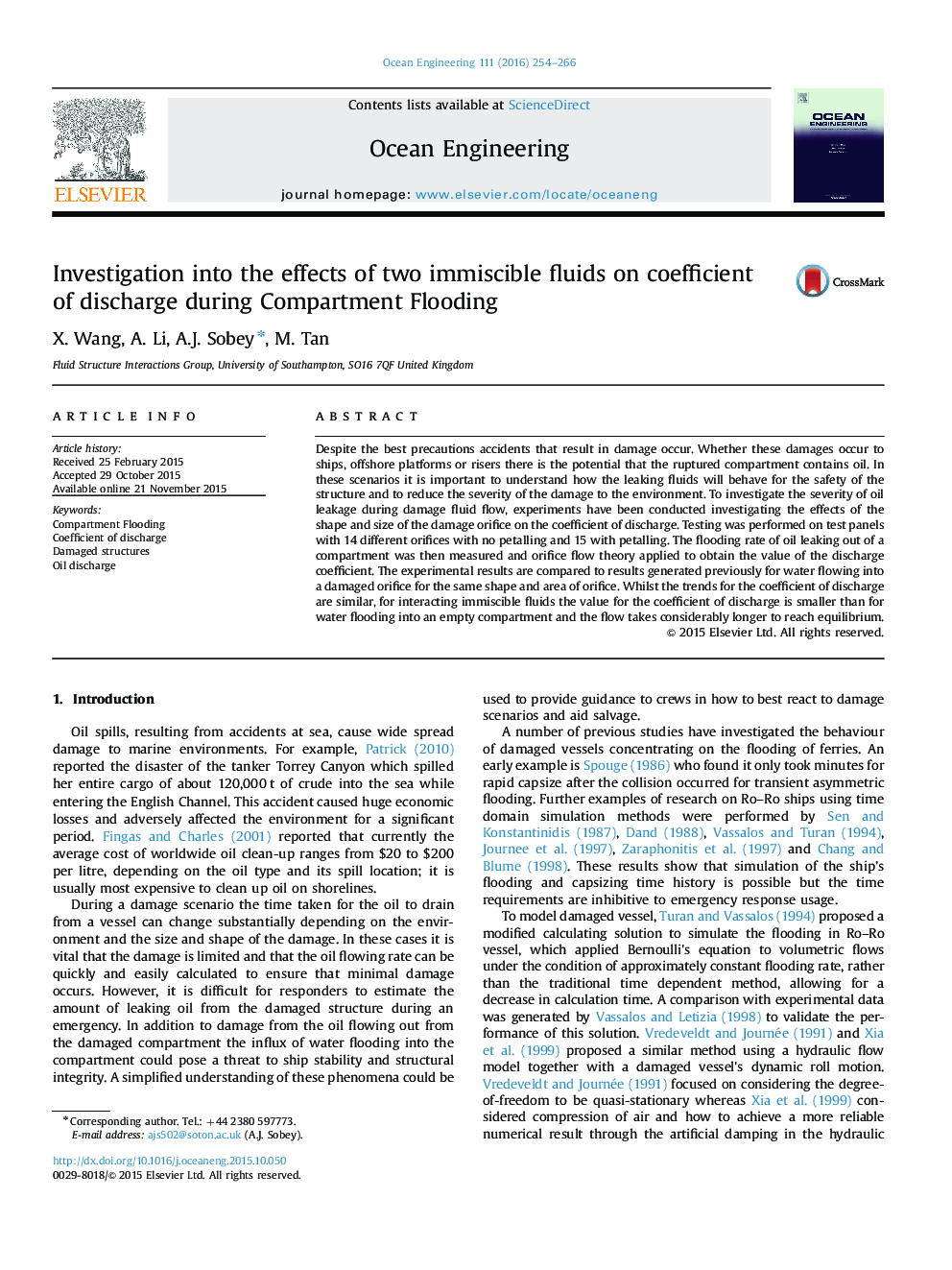| کد مقاله | کد نشریه | سال انتشار | مقاله انگلیسی | نسخه تمام متن |
|---|---|---|---|---|
| 8065084 | 1520679 | 2016 | 13 صفحه PDF | دانلود رایگان |
عنوان انگلیسی مقاله ISI
Investigation into the effects of two immiscible fluids on coefficient of discharge during Compartment Flooding
ترجمه فارسی عنوان
بررسی اثرات دو مایعات ناپیوسته بر ضریب تخلیه در طی سیلاب محفظه
دانلود مقاله + سفارش ترجمه
دانلود مقاله ISI انگلیسی
رایگان برای ایرانیان
کلمات کلیدی
سیلاب محفظه، ضریب تخلیه، سازه های آسیب دیده، تخلیه نفت،
ترجمه چکیده
علیرغم بهترین حوادث احتمالی که باعث آسیب می شود، اتفاق می افتد. این که آیا این خسارت ها به کشتی ها، سیستم عامل های دریایی یا بالابرها اتفاق می افتد، احتمال دارد که بخاری شکسته حاوی روغن باشد. در این شرایط مهم است که بدانیم چگونه مایعات نشتی برای ایمنی ساختار و کاهش شدت آسیب به محیط زیست رفتار می کنند. برای بررسی شدت نشت نفت در جریان جریان مایع آسیب، آزمایشات انجام شده برای بررسی تاثیر شکل و اندازه سوراخ آسیب بر ضریب تخلیه انجام شده است. آزمایش بر روی پانل های آزمایشی با 14 نانومتری بدون پلا تابی و 15 پدالیسی انجام شد. پس از اندازه گیری میزان سیلاب شدن نفت از محفظه و تئوری جریان سوراخ اعمال شده برای به دست آوردن مقدار ضریب تخلیه. نتایج تجربی با نتایج تولید شده در گذشته برای جریان آب به یک سوراخ آسیب دیده برای همان شکل و ناحیه سوراخ مقایسه شده است. در حالی که روند ضریب تخلیه مشابه است، برای تعامل مایعات ناپیوسته مقدار برای ضریب تخلیه کوچکتر از سیلاب آب به یک محفظه خالی است و جریان به طور قابل توجهی طولانی تر برای رسیدن به تعادل است.
موضوعات مرتبط
مهندسی و علوم پایه
سایر رشته های مهندسی
مهندسی دریا (اقیانوس)
چکیده انگلیسی
Despite the best precautions accidents that result in damage occur. Whether these damages occur to ships, offshore platforms or risers there is the potential that the ruptured compartment contains oil. In these scenarios it is important to understand how the leaking fluids will behave for the safety of the structure and to reduce the severity of the damage to the environment. To investigate the severity of oil leakage during damage fluid flow, experiments have been conducted investigating the effects of the shape and size of the damage orifice on the coefficient of discharge. Testing was performed on test panels with 14 different orifices with no petalling and 15 with petalling. The flooding rate of oil leaking out of a compartment was then measured and orifice flow theory applied to obtain the value of the discharge coefficient. The experimental results are compared to results generated previously for water flowing into a damaged orifice for the same shape and area of orifice. Whilst the trends for the coefficient of discharge are similar, for interacting immiscible fluids the value for the coefficient of discharge is smaller than for water flooding into an empty compartment and the flow takes considerably longer to reach equilibrium.
ناشر
Database: Elsevier - ScienceDirect (ساینس دایرکت)
Journal: Ocean Engineering - Volume 111, 1 January 2016, Pages 254-266
Journal: Ocean Engineering - Volume 111, 1 January 2016, Pages 254-266
نویسندگان
X. Wang, A. Li, A.J. Sobey, M. Tan,
